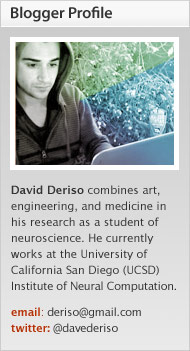« Prev Next »
Although our senses are often too blunt for nature's finer points, there are ways that we can use our cognitive machinery to understand and manipulate ideas beyond our sensory reach. Here, we discuss how the artful brain uses reason and metaphor to overcome the barrier of our senses and paint a picture of the reality beyond our reach.
Lets pretend it's 1632 and you are Galileo and you want to answer a question that other scholars in your field, mainly devout followers of Aristotle, were stuck on: Why do objects move faster and faster as they fall? Your state-of-the-art lab is equipped with a few bottles of wine (you're in Florence, Italy), a scale, a tub of water, a ruler, and a large, accurate to the second but not sub-second clock. What do you do?
 Galileo knew his senses were outgunned, how could you ever see fast enough to quantify acceleration? However, he was clever enough to encode the concepts he could not measure or sense into ideas he could work with. Because the increase in speed as an object falls is a conceptual idea, Galileo used the term acceleration as a metaphor to describe the change speed over time. Then he measured speed and used reason to access acceleration.
Galileo knew his senses were outgunned, how could you ever see fast enough to quantify acceleration? However, he was clever enough to encode the concepts he could not measure or sense into ideas he could work with. Because the increase in speed as an object falls is a conceptual idea, Galileo used the term acceleration as a metaphor to describe the change speed over time. Then he measured speed and used reason to access acceleration.
So whats going on here in a cognitively? Metaphor allows us to take a natural phenomenon, say movement of a particle, and place it into a bite sized idea our brain can understand, like speed or acceleration. Then, reason comes along and allows us to manipulate those ideas, often through equations like speed is the derivative of acceleration.
"Galileo had found a happy fusion of these contrasting approaches. Like Plato, he quested after hidden truth, written deep in the language of mathematics. But experience had shown him that reason, unaided by the senses, can easily be led astray. Passive observation, however, is no better, for nature is too sly an adversary to reveal her most treasured secrets to any fool. You must confront her armed with the best instruments human ingenuity can devise. Even then, she cannot be taken on her own ground. She must be tricked into showing her hand by contriving situations that emphasize the hidden reality. This is the essence of experimental science [...]"
So, to solve the problem, Galileo measured the distance a ball would travel over increasing amounts of time. He did this by uncorking his tub of water and measuring the amount of water that poured into a cup as a ball rolled down a ramp of a known distance. He then weighed the water and compared it to the weight of water obtained from a second of pouring. He plotted this out and, using a little algebra, found that the distance travelled by the ball was equal to half square of the time x 10. If speed is distance over time, he reasoned, then the increase in speed is the change in speed over time, or distance over time squared. By simply rearranging the formula, he found that acceleration was equal to ten!
Although the concepts are simple, without using metaphor and reason, the senses could have never answered this question. So what happens when the sensible world is extrapolated even further? The world as we know it is quite different, and we shall take a closer look in our next discussion.
References:
March, R. H. (1996). A Vast and Most Excellence Science. Physics for poets (4th ed., pp. 8-16). New York: McGraw-Hill.























